英文科技学术论文Introduction写法
- 格式:doc
- 大小:51.00 KB
- 文档页数:2
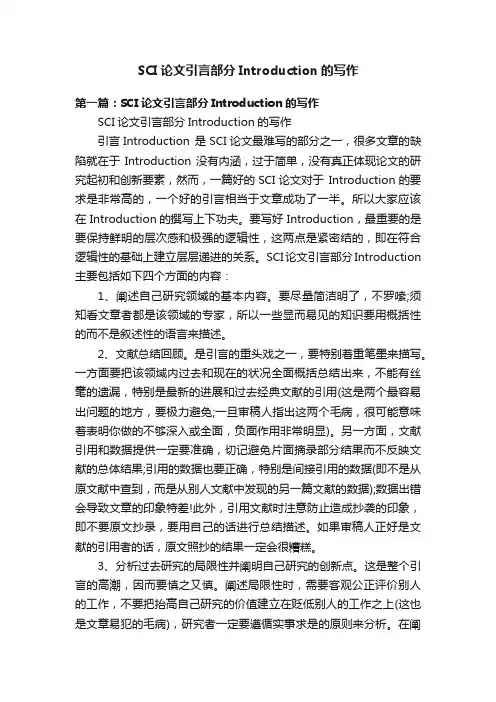
SCI论文引言部分Introduction的写作第一篇:SCI论文引言部分Introduction的写作SCI论文引言部分Introduction的写作引言Introduction 是SCI论文最难写的部分之一,很多文章的缺陷就在于Introduction没有内涵,过于简单,没有真正体现论文的研究起初和创新要素,然而,一篇好的SCI论文对于Introduction的要求是非常高的,一个好的引言相当于文章成功了一半。
所以大家应该在 Introduction的撰写上下功夫。
要写好 Introduction,最重要的是要保持鲜明的层次感和极强的逻辑性,这两点是紧密结的,即在符合逻辑性的基础上建立层层递进的关系。
SCI论文引言部分Introduction 主要包括如下四个方面的内容:1、阐述自己研究领域的基本内容。
要尽量简洁明了,不罗嗦;须知看文章者都是该领域的专家,所以一些显而易见的知识要用概括性的而不是叙述性的语言来描述。
2、文献总结回顾。
是引言的重头戏之一,要特别着重笔墨来描写。
一方面要把该领域内过去和现在的状况全面概括总结出来,不能有丝毫的遗漏,特别是最新的进展和过去经典文献的引用(这是两个最容易出问题的地方,要极力避免;一旦审稿人指出这两个毛病,很可能意味着表明你做的不够深入或全面,负面作用非常明显)。
另一方面,文献引用和数据提供一定要准确,切记避免片面摘录部分结果而不反映文献的总体结果;引用的数据也要正确,特别是间接引用的数据(即不是从原文献中查到,而是从别人文献中发现的另一篇文献的数据);数据出错会导致文章的印象特差!此外,引用文献时注意防止造成抄袭的印象,即不要原文抄录,要用自己的话进行总结描述。
如果审稿人正好是文献的引用者的话,原文照抄的结果一定会很糟糕。
3、分析过去研究的局限性并阐明自己研究的创新点。
这是整个引言的高潮,因而要慎之又慎。
阐述局限性时,需要客观公正评价别人的工作,不要把抬高自己研究的价值建立在贬低别人的工作之上(这也是文章易犯的毛病),研究者一定要遵循实事求是的原则来分析。
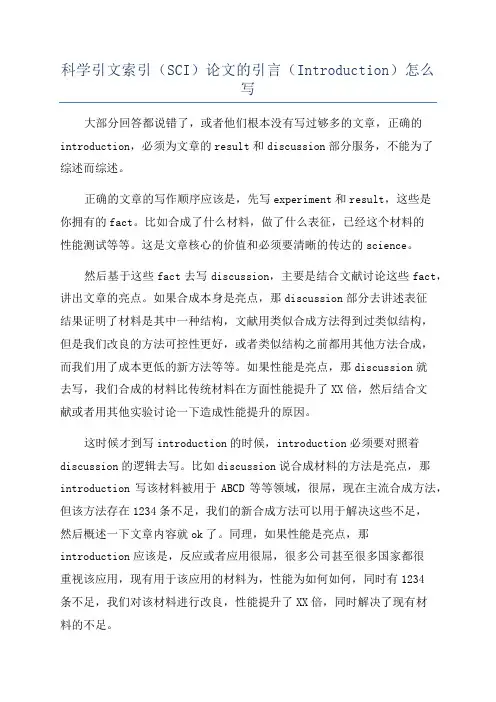
科学引文索引(SCI)论文的引言(Introduction)怎么写大部分回答都说错了,或者他们根本没有写过够多的文章,正确的introduction,必须为文章的result和discussion部分服务,不能为了综述而综述。
正确的文章的写作顺序应该是,先写experiment和result,这些是你拥有的fact。
比如合成了什么材料,做了什么表征,已经这个材料的性能测试等等。
这是文章核心的价值和必须要清晰的传达的science。
然后基于这些fact去写discussion,主要是结合文献讨论这些fact,讲出文章的亮点。
如果合成本身是亮点,那discussion部分去讲述表征结果证明了材料是其中一种结构,文献用类似合成方法得到过类似结构,但是我们改良的方法可控性更好,或者类似结构之前都用其他方法合成,而我们用了成本更低的新方法等等。
如果性能是亮点,那discussion就去写,我们合成的材料比传统材料在方面性能提升了XX倍,然后结合文献或者用其他实验讨论一下造成性能提升的原因。
这时候才到写introduction的时候,introduction必须要对照着discussion的逻辑去写。
比如discussion说合成材料的方法是亮点,那introduction写该材料被用于ABCD等等领域,很屌,现在主流合成方法,但该方法存在1234条不足,我们的新合成方法可以用于解决这些不足,然后概述一下文章内容就ok了。
同理,如果性能是亮点,那introduction应该是,反应或者应用很屌,很多公司甚至很多国家都很重视该应用,现有用于该应用的材料为,性能为如何如何,同时有1234条不足,我们对该材料进行改良,性能提升了XX倍,同时解决了现有材料的不足。
如果不这么写,只是把introduction当做泛泛的短review,文章很容易逻辑很别扭,经常会出现introduction说方法存在问题,然后文章内容是应用该方法去做研究,而不去解决问题。
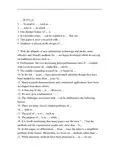
一.典型句式1.… be used to … , such as …2.… refer to … in which …3.One distinct feature of … is …4.In a broader sense, … can be regarded as … that can …5.This paper is most concerned with …6.Emphasis is placed on the design of …7.With the ubiquity of new information technology and media, more effective and friendly methods for … are being developed which do not rely on traditional devices such as …8.Furthermore, the ever decreasing price/performance ratio of ... coupled with recent decreases in... imply that ... can be ...9. The rapidly expanding research in ... is based on ...10. In the last ... years, ... have attracted much attention though they have been studied for more than ... years by ...11. Many research demonstrations and commercial applications have been developed from these efforts.12. A first step of any ... is ... . However, ...13. We now give a definition of ... : ...14. The challenges associated with ... can be attributed to the following factors:15. There are many closely related problems of ...16. ... aims to ...17. The goal of ... is to... , such as ...18. The purpose of ... is to ... , while ...19. It is worth mentioning that many papers use the term “... ,” but the methods and the experimental results only show that ... Is...20. In this paper, we differentiate ... from ... since the latter is a simplified problem of the former. Meanwhile, we focus on ... methods rather than ...21. While numerous methods have been proposed to ... in ..., we areunaware of any surveys on this particular topic. A survey of early ... methods before ... was written by...21.... wrote a more recent survey on ...22.Among ... methods, the ones based on ... have attracted much attention recently and have demonstrated excellent results. Since these ... methods rely heavily on the training sets, we also discuss several ... for this task. 22. A related and important problem is how to evaluate the performanceof the proposed ... methods.23.Many recent ... papers compare the performance of several methods, usually in terms of ...24.It is also worth noticing that many ... have been adopted to evaluate ..., such as ...25.Evaluation becomes more difficult when researchers use different definitions for ...26. In this paper, ... is defined as ... between... and ...27. Consequently, ... is one of the few attempts to ...28. It is also one of the few classes of objects for which ... and, so, some of the ... may be applicable to a much broader class of ... problems.29. To be effective, either ...must ... or ...30. With an aim to give a comprehensive and critical survey of ... methods, this paper is organized as follows: In Section 2, we give a detailed review of techniques to ...31. ... are discussed in Section 3.32. We conclude this paper with a discussion of several promising directions for... in Section 4.133. The basic ideas of ... theory and its extensions as well as many interesting applications can be found in ... ,issues of the Transactions on ... , special issues of other journals (see, e.g. ... ), proceedings of international conferences... , tutorials (see, e.g., [110]).34. For more information one can also visit web pages ... and ...34.The basic notions of ... and ... were introduced during ...35.In this paper, the basic concepts of ... theory are presented. We also point out some research directions and applications based on ...36. In articles [...,...], we discuss in more detail two selected topics, namely, extensions of ... approach and the combination of ... and ...二、常用连接词However, also, in addition, consequently, afterwards, moreover, Furthermore, further, although, unlike, in contrast, Similarly, Unfortunately, alternatively, parallel results, In order to, despite, For example, Compared with, other results, thus, therefore...。
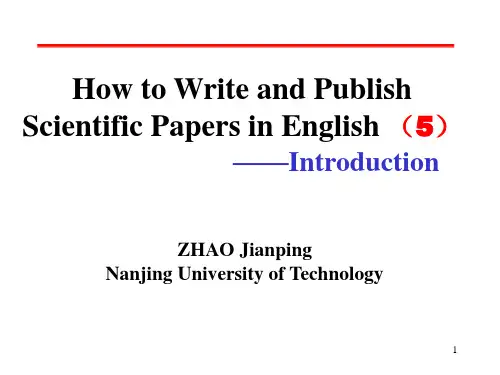
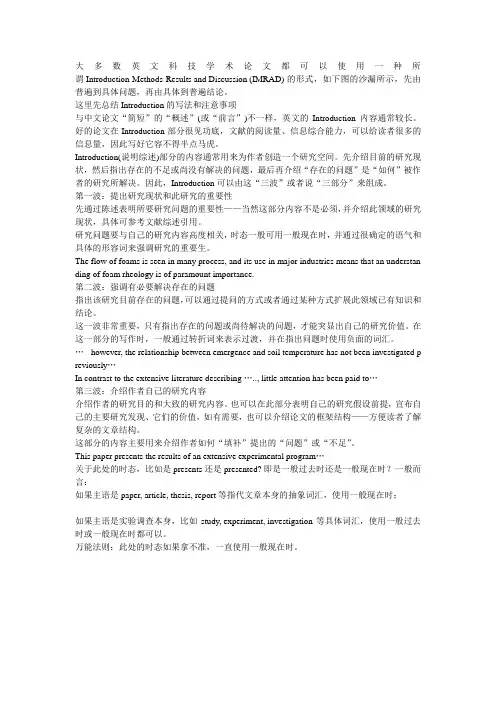
大多数英文科技学术论文都可以使用一种所谓 Introduction-Methods-Results and Discussion (IMRAD) 的形式,如下图的沙漏所示,先由普遍到具体问题,再由具体到普遍结论。
这里先总结Introduction的写法和注意事项与中文论文“简短”的“概述”(或“前言”)不一样,英文的Introduction内容通常较长。
好的论文在Introduction部分很见功底,文献的阅读量、信息综合能力,可以给读者很多的信息量,因此写好它容不得半点马虎。
Introduction(说明综述)部分的内容通常用来为作者创造一个研究空间。
先介绍目前的研究现状,然后指出存在的不足或尚没有解决的问题,最后再介绍“存在的问题”是“如何”被作者的研究所解决。
因此,Introduction可以由这“三波”或者说“三部分”来组成。
第一波:提出研究现状和此研究的重要性先通过陈述表明所要研究问题的重要性——当然这部分内容不是必须,并介绍此领域的研究现状,具体可参考文献综述引用。
研究问题要与自己的研究内容高度相关,时态一般可用一般现在时,并通过很确定的语气和具体的形容词来强调研究的重要生。
The flow of foams is seen in many process, and its use in major industries means that an understan ding of foam rheology is of paramount importance.第二波:强调有必要解决存在的问题指出该研究目前存在的问题,可以通过提问的方式或者通过某种方式扩展此领域已有知识和结论。
这一波非常重要,只有指出存在的问题或尚待解决的问题,才能突显出自己的研究价值。
在这一部分的写作时,一般通过转折词来表示过渡,并在指出问题时使用负面的词汇。
… however, the relationship between emergence and soil temperature has not been investigated p reviously…In contrast to the extensive literature describing ….., little attention has been paid to…第三波:介绍作者自己的研究内容介绍作者的研究目的和大致的研究内容。
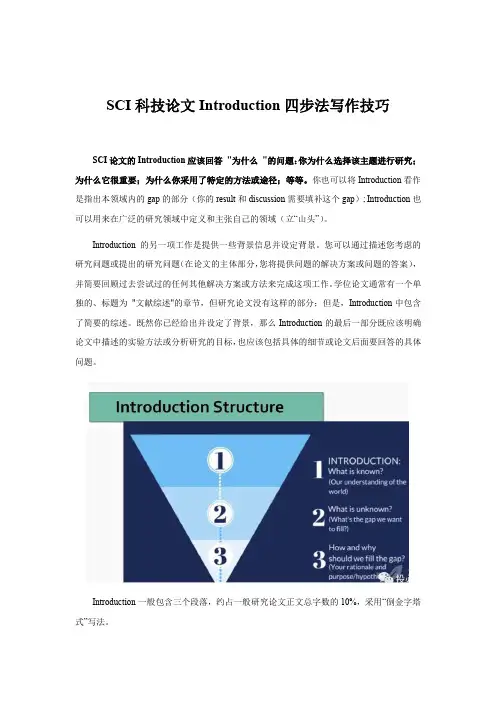
SCI科技论文Introduction四步法写作技巧SCI论文的Introduction应该回答"为什么"的问题:你为什么选择该主题进行研究;为什么它很重要;为什么你采用了特定的方法或途径;等等。
你也可以将Introduction看作是指出本领域内的gap的部分(你的result和discussion需要填补这个gap); Introduction也可以用来在广泛的研究领域中定义和主张自己的领域(立“山头”)。
Introduction的另一项工作是提供一些背景信息并设定背景。
您可以通过描述您考虑的研究问题或提出的研究问题(在论文的主体部分,您将提供问题的解决方案或问题的答案),并简要回顾过去尝试过的任何其他解决方案或方法来完成这项工作。
学位论文通常有一个单独的、标题为"文献综述"的章节,但研究论文没有这样的部分;但是,Introduction中包含了简要的综述。
既然你已经给出并设定了背景,那么Introduction的最后一部分既应该明确论文中描述的实验方法或分析研究的目标,也应该包括具体的细节或论文后面要回答的具体问题。
Introduction一般包含三个段落,约占一般研究论文正文总字数的10%,采用“倒金字塔式”写法。
四步法写Introduction1. 提供背景资料,设置背景Introduction的这一初始部分为读者准备了后面更详细、更具体的信息。
前几句一般都是概括性的。
以下是一些例子:一篇关于土壤中有机物的论文可以这样开头:"可持续的作物生产是土壤的物理、化学和生物特性的函数,而这些特性又明显地受到土壤中有机物的影响。
”一篇讨论细菌在治疗癌症方面可能发挥的有益作用的论文,可以这样开头。
"细菌作为抗癌剂的作用早在一百年前就被认识到了。
”一篇关于锂电池的论文可以用以下句子来介绍研究内容:“锂离子电池的快速增长及其新的用途,如为电动汽车提供动力和为电网供应储存电能,这就要求有更可靠的方法来了解和预测电池的性能和寿命。

朱嵘良, S121074一.典型句式1.… be used to … , such as …2.… refer to … in which …3.One distinct feature of … is …4.In a broader sense, … can be regarded as … that can …5.This paper is most concerned with …6.Emphasis is placed on the design of …7.With the ubiquity of new information technology and media, more effective and friendly methods for … are being developed which do not rely on traditional devices such as …8.Furthermore, the ever decreasing price/performance ratio of ... coupled with recent decreases in... imply that ... can be ...9. The rapidly expanding research in ... is based on ...10. In the last ... years, ... have attracted much attention though they have been studied for more than ... years by ...11. Many research demonstrations and commercial applications have been developed from these efforts.12. A first step of any ... is ... . However, ...13. We now give a definition of ... : ...14. The challenges associated with ... can be attributed to the following factors:15. There are many closely related problems of ...16. ... aims to ...17. The goal of ... is to... , such as ...18. The purpose of ... is to ... , while ...19. It is worth mentioning that many papers use the term “... ,” but the methods and the experimental results only show that ... Is...20. In this paper, we differentiate ... from ... since the latter is a simplified problem of the former. Meanwhile, we focus on ... methods rather than ...21. While numerous methods have been proposed to ... in ..., we are unaware of any surveys on this particular topic. A survey of early ... methods before ... was written by...21.... wrote a more recent survey on ...22.Among ... methods, the ones based on ... have attracted much attention recently and have demonstrated excellent results. Since these ... methods rely heavily on the training sets, we also discuss several ... for this task. 22. A related and important problem is how to evaluate the performanceof the proposed ... methods.23.Many recent ... papers compare the performance of several methods, usually in terms of ...24.It is also worth noticing that many ... have been adopted to evaluate ..., such as ...25.Evaluation becomes more difficult when researchers use different definitions for ...26. In this paper, ... is defined as ... between... and ...27. Consequently, ... is one of the few attempts to ...28. It is also one of the few classes of objects for which ... and, so, some of the ... may be applicable to a much broader class of ... problems.29. To be effective, either ...must ... or ...30. With an aim to give a comprehensive and critical survey of ... methods, this paper is organized as follows: In Section 2, we give a detailed review of techniques to ...31. ... are discussed in Section 3.32. We conclude this paper with a discussion of several promising directions for... in Section 4.133. The basic ideas of ... theory and its extensions as well as many interesting applications can be found in ... ,issues of the Transactions on ... , special issues of other journals (see, e.g. ... ), proceedings of international conferences... , tutorials (see, e.g., [110]).34. For more information one can also visit web pages ... and ...34.The basic notions of ... and ... were introduced during ...35.In this paper, the basic concepts of ... theory are presented. We also point out some research directions and applications based on ...36. In articles [...,...], we discuss in more detail two selected topics, namely, extensions of ... approach and the combination of ... and ...二、常用连接词However, also, in addition, consequently, afterwards, moreover, Furthermore, further, although, unlike, in contrast, Similarly, Unfortunately, alternatively, parallel results, In order to, despite, For example, Compared with, other results, thus, therefore...。
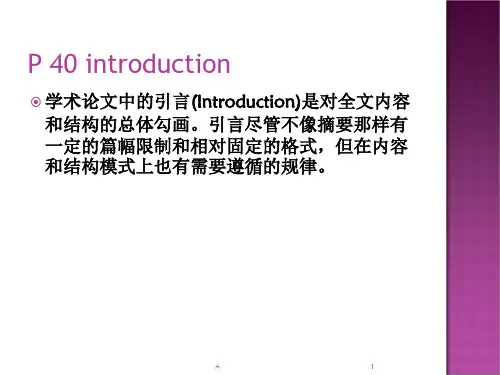
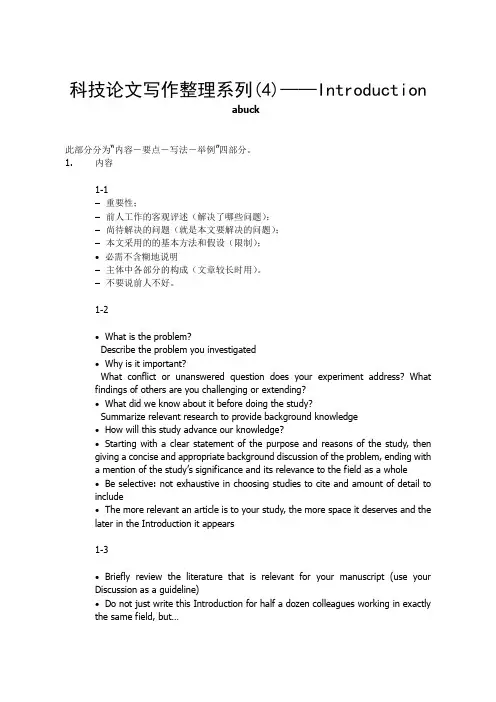
科技论文写作整理系列(4)——Introductionabuck此部分分为―内容-要点-写法-举例‖四部分。
1.内容1-1–重要性;–前人工作的客观评述(解决了哪些问题);–尚待解决的问题(就是本文要解决的问题);–本文采用的的基本方法和假设(限制);•必需不含糊地说明–主体中各部分的构成(文章较长时用)。
–不要说前人不好。
1-2• What is the problem?Describe the problem you investigated• Why is it important?What conflict or unanswered question does your experiment address? What findings of others are you challenging or extending?• What did we know about it before doing the study?Summarize relevant research to provide background knowledge• How will this study advance our knowledge?• Starting with a clear statement of the purpose and reasons of the study, then giving a concise and appropriate background discussion of the problem, ending witha mention of the study’s signifi cance and its relevance to the field as a whole• Be selective: not exhaustive in choosing studies to cite and amount of detail to include• The more relevant an article is to your study, the more space it deserves and the later in the Introduction it appears1-3• Briefly review the literature that is relevant for your manuscript (use your Discussion as a guideline)• Do not just write this Introduction for half a dozen colleagues working in exactly the same field, but…• write for a range of interested scientists• Finish with the aims of your work and present a clear hypothesis• Briefly review the literature• Address a wider audience than those working in exactly the same field• Give the aims of your research and a good hypothesis• A goo d hypothesis is one that can be tested, but it does not need to be ―correct‖• Explain why you did your research• The fact that nobody has done it before is not a good reason• Your study may follow logically from previous work• Your project may have been inspired by a practical problem1-4工作目的对工作目的的评价:该工作为什么很重要?工作背景:谁做了什么工作?做得怎么样?以前我们做了哪些工作?导读:读者应该注意该文章的哪些方面?有意义的要点有哪些?结论:读者期望什么样的结论呢?在提纲的前几个版本中,你应该包括实验过程中涉及到的所有内容(在这一点上,就像是段落的副标题)1-5引言在内容上应包括:为什么要进行这项研究?立题的理论或实践依据是什么?拟创新点何在?理论与(或)实践意义是什么?告诉读者你为什么要进行这项研究是引言的主要内容和目的,这其中也包括说明这项研究的理论和(或)实践意义。

科研类型英语作文模板英文回答:1. Introduction。
In the realm of academic research, the articulation of a compelling research question is paramount to the pursuit of knowledge and the advancement of scientific endeavors. A well-crafted research question serves as the cornerstone of any research project, providing a clear and concise framework for inquiry and guiding the subsequent steps of the research process. To formulate an effective research question, it is essential to delve into the existing body of knowledge, identify gaps or inconsistencies, and formulate a specific and testable question that addresses these shortcomings.2. Literature Review。
A thorough literature review is indispensable forsituating your research within the broader context of the field and establishing the significance of your inquiry. Critically examining existing research enables you to identify areas where knowledge is lacking, refine your research question, and develop a sound theoretical foundation for your study. By synthesizing the findings of previous studies, you can pinpoint areas where further investigation is warranted and contribute to the cumulative body of knowledge in your field.3. Research Design。

科技学术论文Introduction引言的主要内容是交代此项研究的来龙去脉,简要说明课题的缘起与背景,性质与意义,动机与目的、主要理论根据及其基本原理等,同时指出相关领域内前任的研究成果、存在问题和知识空白,以表明本项研究的连续性和需要性,叙述有关本课题的历史沿革是为了温故而知新,但应注意掌握适当的范围和尺度,一般来说仅需要介绍极密切的有关史料即可,不宜泛泛赘述大量历史文献,否则会造成Introduction长而乏味。
first:提出研究现状和此研究的重要性second:强调有必要解决存在的问题third:介绍作者自己的研究内容、提出创新性逻辑的连贯内容的创新词汇简洁时态1. What is an introduction?The introduction section shows the questions that should be answered for the readers once they finish reading the “Introduction”.2. What’s the purpose of the introduction?The introduction comes at the start of a piece of writing. Without this part, the reader cannot easily understand the more detailed information about the research that comes later in the thesis.It introduces:(1).the research by situating it (by giving background),(2).presenting the research problem , and saying how and why this problem will be solved , (3).explaining why the research is being done. (ratio'nale) which is crucial for the reader to understand the significance of the study.3. How should I start?You may want to start your introduction by describing the problem you are trying to solve, or the aim of your work4. How to build a model of introduction?Read the following introduction and decide what the author tells us in each sentence.5. The model of introduction.(1) establishes the importance of this research topic确立研究主题的重要性(2) provides general background information for the reader.为读者提供总体的背景信息(3) in a more specific/detailed way, using research references to support both the background facts and the claim for significance.与第1、2句的做法一样,但是更具体(4) describes the general problem area or the current research focus of the field.描述了所研究领域的一般性问题或当前的研究焦点(5) provides a transition between the general problem area and the literature review提供了总体问题领域到文献综述之间的一个过渡(6) provides a brief overview of key research projects in this area.概述了此研究领域重要的研究项目(7) describes a gap in the research描述了已有研究的空白(8) describes the paper itself描述了论文本身的工作(9) gives details about the methodology详细描述了论文中所用的方法(10) announces the findings公布了论文的结论6. Four components of a model.(1)Establish the importance of your fieldProvide background/ facts/information (possibly from research)Define the terminology in the title/key wordsPresent the problem area/current research focus确立研究领域的重要性提供背景事实或信息(有可能来自现有文献)定义题目或关键词中的术语给出所研究问题的范畴或目前的研究重点(2)Previous and/or current research and contributions前期的研究或目前的研究及其贡献(3)Locate a gap in the researchDescribe the problem you will addressPresent a prediction to be tested确定已有研究工作的空白;描述你要解决的问题呈现要验证的预测(4)Describe the present paper描述现在的论文7.Grammar and writing skills.语法时态写作技巧8. V ocabulary词汇的简洁举例三篇文章:1.Gene expression profiling and pathway analysis of hepatotoxicity induced by triptolide in Wistar rats在Wistar大鼠中,通过基因表达谱和通路分析由雷公藤甲素诱导的肝毒性引言的主要内容是交代此项研究的来龙去脉,例如本文中,简要说明课题的缘起与背景,TP的性质Triptolide (diterpenoid triepoxide, TP), purified from the shrublike vine Tripterygium wilfondii Hook F (TWHF)与药理学意义possesses anti-inflammatory, anti-fertility, anti-neoplastic and immunosuppressive activities 实验的动机However, clinical use of TWHF or TP has been limited due to severe adverse reactions, such as gastrointestinal upset, diarrhea, reproductive toxicity and problems associated with circulatory systems目的we hypothesized that liver is a major toxic target of TP treatment. Thus, it is essential to elucidate the mechanism of TP-induced hepatotoxicity from a safety point of view.the aim of our study was to identify candidate genes associated with TP treatment and to provide novel insights to better elucidate the mechanisms of toxic effects of TP.主要理论根据及其基本原理Considering that microarray technology is recognized as a reliable toxicologica method to determine mechanisms of drug-induced toxicity, identify biomarkers and to predict chemical toxicity.Therefore, the aim of our study was to identify candidate genes associated with TP treatment and to provide novel insights to better elucidate the mechanisms of toxic effects of TP.同时指出相关领域内前任的研究成果possesses anti-inflammatory, anti-fertility, anti-neoplastic and immunosuppressive activities (Chen, 2001; Huynh et al., 2000; Panichakul et al., 2006).have emerged as treatments of rheumatoid arthritis, systemic lupus erythematosus, nephritis, leprosy and asthma (Lipsky and Tao, 1997; Liu et al., 2005; Zhang et al., 2010).clinical use of TWHF or TP has been limited due to severe adverse reactions, such as gastrointestinal upset, diarrhea, reproductive toxicity and problems associated with circulatory systems (Hikim et al., 2000; Ni et al., 2008; Yang et al., 2012; Zhang et al., 2011).Recently, hepatotoxicity induced by various extracts of TWHF in animals and humans has been reported by many researches (He et al., 2006; Mei et al., 2005; Wang et al., 2007) To date, only mitochondrial respiratory chain inhibition, lipid peroxidation, DNA damage and hepatocyte apoptosis were proposed to be involved in TP-induced liver injury (Fu et al., 2011; Mei et al., 2005; Yao et al., 2008).等存在问题和知识空白Hepatic differential gene expression was analyzed using oligonucleotide microarray analysis for over-represented functions and phenotypically anchored to complementary histopathologic, biochemical, and dosimetry data in the liver. The results indicate that TP affects diverse cellular pathways, including insulin signaling pathway, glucose metabolism, cell cycling, oxidative stress and apoptosis. These data provide a clearer understanding of the molecular mechanisms of TP-induced hepatotoxicity, as well as useful information for predicting drug hepatotoxicity.以表明本项研究的连续性和需要性,叙述有关本课题的历史沿革是为了温故而知新,Triptolide (diterpenoid triepoxide, TP), purified from the shrublike vine Tripterygium wilfondii Hook F (TWHF), possesses anti-inflammatory, anti-fertility, anti-neoplastic and immunosuppressive activities (Chen, 2001; Huynh et al., 2000; Panichakul et al., 2006). Recently, the methanol/chloroform (T2) and ethyl acetate (EA) extracts of TWHF, in which TP was identified as the principal active compound, have emerged as treatments of rheumatoid arthritis, systemic lupus erythematosus, nephritis, leprosy and asthma (Lipsky and Tao, 1997; Liu et al., 2005; Zhang et al., 2010). However, clinical use of TWHF or TP has been limited due to severe adverse reactions, such as gastrointestinal upset, diarrhea, reproductive toxicity and problems associated with circulatory systems (Hikim et al., 2000; Ni et al., 2008; Yang et al., 2012; Zhang et al., 2011).Recently, hepatotoxicity induced by various extracts of TWHF in animals and humans has been reported by many researches (He et al., 2006; Mei et al., 2005; Wang et al., 2007). Besides, Liu et al., (2010) found that potential hepatotoxicity in rats treated with TP for 28 days was associated with increasing levels of serum alanine aminotransferase (ALT) and aspartate aminotransferase (AST) (Liu et al., 2010). Moreover, it was reported that oral administration of TP to rats could lead to liver injury or even death (Fu et al., 2011). In addition to this, our previous investigation showed that the concentration of TP found in liver exceeds those observed in other tissues, such as spleen, lung, heart, and kidney (unpublished data). On account of this, we hypothesized that liver is a major toxic target of TP treatment. Thus, it is essential to elucidate the mechanism of TP-induced hepatotoxicity from a safety point of view.Unfortunately, its underling mechanisms are still insufficiently recognized. To date, only mitochondrial respiratory chain inhibition, lipid peroxidation, DNA damage and hepatocyte apoptosis were proposed to be involved in TP-induced liver injury (Fu et al., 2011; Mei et al.,2005; Yao et al., 2008). Considering that microarray technology is recognized as a reliable toxicologica method to determine mechanisms of drug-induced toxicity, identify biomarkers and to predict chemical toxicity (Lee et al., 2010; Wang et al., 2011). Therefore, the aim of our study was to identify candidate genes associated with TP treatment and to provide novel insights to better elucidate the mechanisms of toxic effects of TP.Here, we describe genome-wide gene expression in the TP-exposed Wistar female rat liver. Differential gene expression was evaluated in 6-week-old female Wistar rat livers following 14 days of continuous exposure to large doses of TP. Hepatic differential gene expression was analyzed using oligonucleotide microarray analysis for over-represented functions and phenotypically anchored to complementary histopathologic, biochemical, and dosimetry data in the liver. The results indicate that TP affects diverse cellular pathways, including insulin signaling pathway, glucose metabolism, cell cycling, oxidative stress and apoptosis. These data provide a clearer understanding of the molecular mechanisms of TP-induced hepatotoxicity, as well as useful information for predicting drug hepatotoxicity.2.综述Blood vessels, a potential therapeutic target in rheumatoid arthritis?血管,类风湿性关节炎潜在的治疗靶标?IntroductionRheumatoid arthritis (RA) can be defined as a disease of the blood vessels, both micro- and macro-vessels. The formation of new micro-vessels is in fact necessary to afford the nutritional supply to proliferating synovial pannus, while macro-vessels are the site where accelerated atherosclerosis driven by disease’s systemic inflammation develops. New vessels formation on one side, and atherosclerotic plaque progression on the other, might seem two different biological phenomena, the first related to the articular involvement of the disease, the second to its main systemic complication. In this context, targeting blood vessels in RA might mean either attempting to reduce synovial vascular supply starving the synovial pannus limiting its proliferation or, in the other case, trying to limit macro-vessels’damage outside the joint. In this review we will analyse the possibility of targeting synovial microvessels to treat rheumatoid arthritis, but we will discuss as well the evidence supporting a link between micro- and macro-vascular involvements in RA.综述的介绍,介绍所提到物质的基本概念,简要说明课题的缘起与背景,RA与血管生成相关,与血管生成的必要性,在这里,说明该文章立题的主要依据与主要原理,并提出在此综述中接下来会说到的内容,如:作者将分析滑膜微血管治疗类风湿关节炎的可能性,且讨论,血管与RA微观和宏观之间联系的证据。
好的论⽂Introduction,应该这样写!超实⽤⼲货分享!(附下载)SCI论⽂写作特辑- 第⼆期 -论⽂写作猛如虎,Introduction就是开门见⼭的⼤⽼虎...Introduction引⾔部分是论⽂写作第⼀关,通过呈现研究课题所折射的研究理论来说服⽬标读者。
对于英⽂⽔平捉襟见肘的科研者来说,多掌握⼀些常⽤句式能够很好地提升paper的可读性。
本期SCI论⽂写作分享,⼩艾就为⼤家总结⼀些Introduction的常⽤句型及句式。
⽅便⼤家写论⽂的时候,直接从中挑选使⽤。
值得收藏!(⽂末附PDF下载⽅式)⼀般来说,Introduction的常规写作顺序:1. 确⽴研究领域的重要性2. 早前、当前的研究贡献3. 差距/疑问/难题/评论4. 当前的研究⼯作确⽴研究领域的重要性01 A major current focus in __ is how to ensure sustainability of…__ 当前的⼀个主要重点是如何确保...的可持续性02 Much research in recent years has focused on __近年来的许多研究都集中在 __03 Analysis of change in __ is vital for two important reasons: …__ 变化分析⾄关重要,有两个重要原因:...04 It is of interest to know whether __still hold true.知道__是否仍然正确是很重要的。
05 The past decade has seen the rapid development of X in many ...在过去的⼗年⾥,__见证了许多...的快速发展。
06 The issue of__has received considerable critical attention.__的问题受到了相当多的批判性关注。
大多数英文科技学术论文都可以使用一种所谓Introduction-Methods-Results and Discussion (IMRAD) 的形式,如下图的沙漏所示,先由普遍到具体问题,再由具体到普遍结论。
这里先总结Introduction的写法和注意事项。
与中文论文“简短”的“概述”(或“前言”)不一样,英文的Introduction内容通常较长。
好的论文在Introduction部分很见功底,文献的阅读量、信息综合能力,可以给读者很多的信息量,因此写好它容不得半点马虎。
Introduction(说明综述)部分的内容通常用来为作者创造一个研究空间。
先介绍目前的研究现状,然后指出存在的不足或尚没有解决的问题,最后再介绍“存在的问题”是“如何”被作者的研究所解决。
因此,Introduction可以由这“三波”或者说“三部分”来组成。
具体而言,这“三波”如此展开:
第一波:提出研究现状和此研究的重要性
先通过陈述表明所要研究问题的重要性——当然这部分内容不是必须,并介绍此领域的研究现状,具体可参考文献综述引用。
研究问题要与自己的研究内容高度相关,时态一般可用一般现在时,并通过很确定的语气和具体的形容词来强调研究的重要生。
The flow of foams is seen in many process, and its use in major industries means that an understanding of foam rheology is of paramount importance.
第二波:强调有必要解决存在的问题
指出该研究目前存在的问题,可以通过提问的方式或者通过某种方式扩展此领域已有知识和结论。
这一波非常重要,只有指出存在的问题或尚待解决的问题,才能突显出自己的研究价值。
在这一部分的写作时,一般通过转折词来表示过渡,并在指出问题时使用负面的词汇。
… ; however, the relationship between emergence and soil temperature has not been investigated previously…
In contrast to the extensive literature describing ….., little attention has been paid to…第三波:介绍作者自己的研究内容
介绍作者的研究目的和大致的研究内容。
也可以在此部分表明自己的研究假设前提,宣布自己的主要研究发现、它们的价值,如有需要,也可以介绍论文的框架结构——方便读者了解复杂的文章结构。
这部分的内容主要用来介绍作者如何“填补”提出的“问题”或“不足”。
This paper presents the results of an extensive experimental program…
关于此处的时态,比如是presents还是presented? 即是一般过去时还是一般现在时?一般而言:
•如果主语是paper, article, thesis, report等指代文章本身的抽象词汇,使用一般现在时;
•如果主语是实验调查本身,比如study, experiment, investigation等具体词汇,使用一般过去时或一般现在时都可以。
万能法则:此处的时态如果拿不准,一直使用一般现在时。